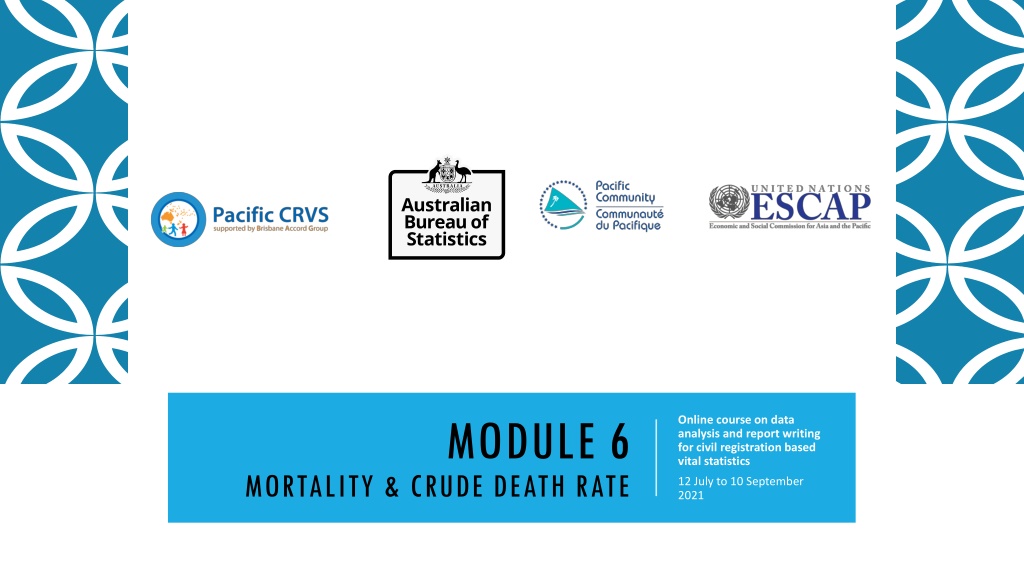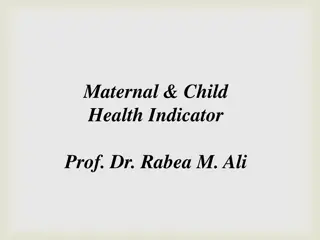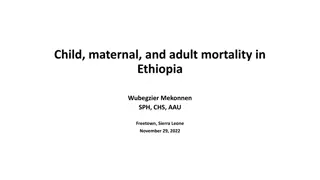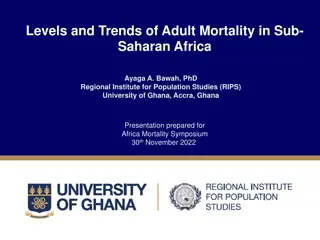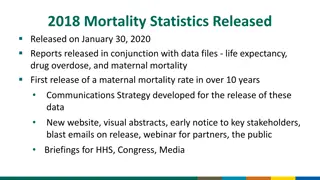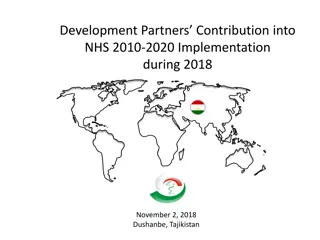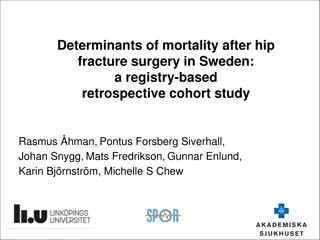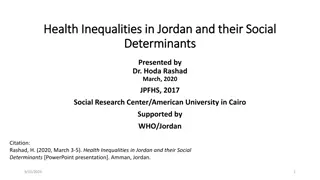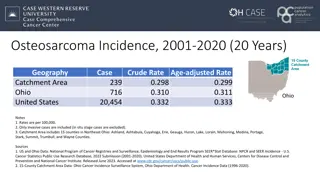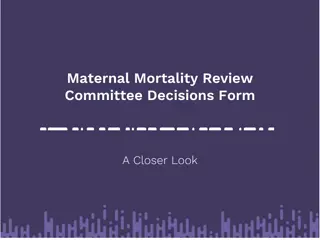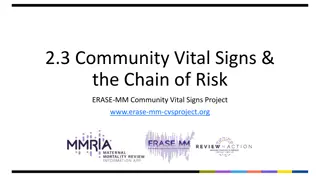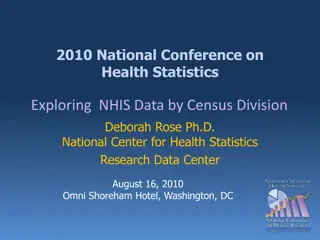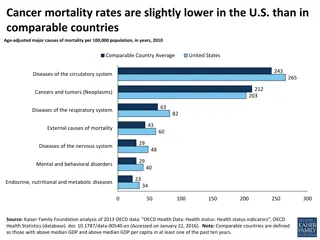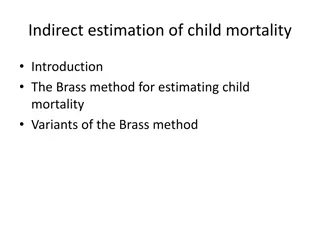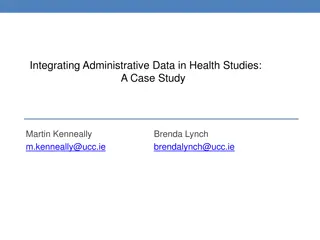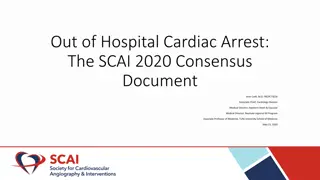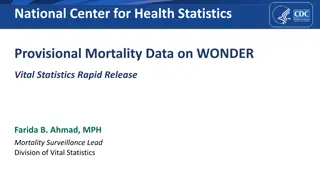Importance of Mortality Data in Health Outcomes Analysis
Mortality data serves as a crucial indicator of quality of life and health outcomes. It helps assess the level of health in a population by understanding factors such as age at death, comparison to global norms, and trends over time. This data is vital for population health planning, resource allocation, evaluating new treatments and services, and guiding epidemiological research. Understanding the parameters affecting mortality, such as demographics, healthcare quality, environmental conditions, lifestyle factors, and socio-economic status, is essential for effective health analysis.
Download Presentation

Please find below an Image/Link to download the presentation.
The content on the website is provided AS IS for your information and personal use only. It may not be sold, licensed, or shared on other websites without obtaining consent from the author. Download presentation by click this link. If you encounter any issues during the download, it is possible that the publisher has removed the file from their server.
E N D
Presentation Transcript
MODULE 6 Online course on data analysis and report writing for civil registration based vital statistics MORTALITY & CRUDE DEATH RATE 12 July to 10 September 2021
MORTALITY DATA IMPORTANCE Mortality data is an indicator Quality of life Health The level of mortality is an essential measure of health outcomes. We are interested in how old people are when they die, how this compares to accepted norms or other countries, and how this is changing over time.
USES OF MORTALITY DATA Population Health planning and resource allocation To measure the success of new treatment To measure the success of health services To provide clues for epidemiological research
KNOW THE SYSTEM Data source: 8 Jurisdictions of RBDMS and coronial system Official release of Mortality Statistics 88% vs 12% 2019: 169,301 deaths 109.1 : 100 Perinatal and general deaths Median age at death: 78.8 years (M); 84.8 years (F)
QUESTIONS ON SYSTEM IN OWN COUNTRY Source of Mortality data? Community deaths included? Deaths that occur abroad? Stillbirths collected? Any requests for mortality data by government or others in your country?
PARAMETERS AFFECTING MORTALITY Demographic composition of the population, i.e. the age and sex distribution; Quality and utilization of health and medical services such as immunization programmes, maternal and child health care, primary health care, etc.; Environmental conditions and availability of infrastructure such as housing, water supply, sanitation, waste disposal; Lifestyle factors, such as abuse of alcohol and tobacco; Work-related dangers; Exposure to events outside individual control such as natural disasters, war; Socio-economic status, such as income and education.
MORTALITY DATA NEEDS Need to be comparable Over time Should identify vulnerable populations Should report key variables for country e.g. ethnicity, place of death Be disaggregated by age, sex, usual residence Measures used include Numbers Rates Proportional mortality
MEASURES OF ALL-CAUSE MORTALITY Absolute number of deaths Crude death rates Age-specific death rates Age-standardized death rates Life expectancy
DATA CLEANSE REMINDERS No duplicates Important fields are filled in (age, date of death, sex, place of death, usual residence) Consideration of scope: No stillbirths Deaths abroad Coverage of deaths in community and hospital Cause of death consistency check no terms like old age with infants, females with terms like prostate cancer
SIMPLE TABULATIONS Source: Australian Bureau of Statistics
NUMBER OF DEATHS Death data tabulated by sex and age group are important in their own right easily understood by decision makers resonates with the community Deaths are also the basis for all further calculations on age- specific and age-standardized mortality
QUESTION: Which country has higher mortality? Country A had 65,000 deaths in 2020 Country B had 1,000 deaths in 2020
ANSWER: WE DONT KNOW The number of deaths alone does not tell us anything about the mortality in a country. A large number of deaths may simply reflect a large population of people more likely to die (the very old). Data in 2020 Country A Country B Country Papua New Guinea Tonga Data from the World Population Prospects 2019 Population 2020 8,947,000 106,000 Deaths 65,000 1,000
THE CRUDE DEATH RATE (CDR) The most frequently used measure of general mortality CDR = the number of deaths in a defined period (usually a calendar year) per 1,000 people. It is defined as crude because does not account for the age (and sex) composition of a population.
THE CRUDE DEATH RATE (CDR) Why we use the CDR: easy to understand requires the least amount of information Provides an absolute rate for a year helps use understand mortality s contribution to population growth
CRUDE DEATH RATE IN SMALL POPULATIONS Generally, CDR = the number of deaths occurring in a year divided by the population at midyear, times 1000. If we aggregate over 5 years, divide the average number of deaths over this period by the population size at the midpoint of these 5 years. CDR of 5-year period = 1000 * (Average number of births over 5 years/Midpoint population) Total number of deaths in period of interest number of years in the period of interest mid point population for the period of interest x 1000 CDR =
CRUDE DEATH RATE IN SMALL POPULATIONS Average number of deaths from 2013 2017 is 250, we will need to divide this by our midpoint population. Our midpoint is July 1, 2015. (Why?) Let s assume the population was 15,645 on July 1, 2015. We then perform the calculation: 250 5 15,645 x 1000 = 3.2 We can say there was an average annual rate of 3.2 deaths per 1,000 population in 2013 2017.
CRUDE DEATH RATE BY SEX Useful to calculate the CDR for males, females, and both sexes combined. Expect the CDR for males to be higher than for females. Deviations from this pattern could indicate that women and girls face severe disadvantages in terms of health and nutrition. Alternatively, there may be problems with data completeness and quality with systematic underreporting of female deaths. The CDR would usually be reported with confidence intervals, which we will examine in the next chapter.
QUESTION: Which country has higher mortality? Country X had a CDR of 9 in 2020 Country Y had a CDR of 6 in 2020
ANSWER: WE DONT KNOW The CDR is also influenced by the population age structure. Populations with a large proportion of young children or a high proportion of elderly people will have relatively higher crude death rates because mortality risks are highest at very young and the oldest ages. Country CDR Life expectancy at birth Country X (Japan) 9 84 Country Y (Fiji) 6 71
MUST STANDARDIZE TO MAKE COMPARISONS Two populations may have different crude death rates even if mortality at each age is the same. Country A may have lower mortality at each age than B, yet A may have a higher CDR! how??
LOWER LIMITS OF THE CDR Demographers have demonstrated that there is generally a lower limit for the CDR of around 5 per 1000. Any CDR below 5 per 1000 should be treated with extreme caution as such a figure is strongly suggestive of INCOMPLETE death registration.
ASSIGNMENT Clean your death records file Tabulations: Deaths by sex and year (incl. aggregate) Deaths by age group and sex Deaths by ethnicity (if relevant) Deaths by usual residence Proportional Age Distribution of deaths REMEMBER: distribute not stated ages if needed Compute the Crude death rate Describe key points of tables and graphs
